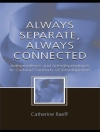Written by three experienced occupational therapists, this book offers a combination of theory and strategies. It is a perfect tool for those working with young children, but also broad enough to be adapted for older children and adults. Building Bridges provides creative techniques and useful tips while offering innovative strategies and practical advice for dealing with everyday challenges, including managing behaviors, improving muscle tone, developing social skills, selecting diets, and more. Part one explains the role of the occupational therapists in treatment and examines sensory integration theories. Part two offers methods of identifying sensory problems in children along with numerous strategies and activities.
Helpful topics include:
- What is Occupational Therapy?
- What is Sensory Integration?
- What are the Sensory Systems?
- Identifying Problems with Sensory Integration Strategies for Challenging Behaviors
- Ideas for Self Care Skills
- Adapting Home, School, and Child Care Settings
สารบัญ
Foreword
Letter to the Reader
What Is in This Book?
PART 1
Chapter 1: What is ASD and Occupational Therapy?
Chapter 2: What Is Sensory Integration?
Chapter 3: What Are The Sensory Systems?
PART 2
Chapter 4: Identifying Problems with Sensory Integration
Chapter 5: Strategies for Challenging Behaviors
Chapter 6: Ideas for Self-care skills
Chapter 7: Adapting Home, School and Childcare Settings
Chapter 8: Activity Suggestions
Chapter 9: Equipment and Resources
References
About the Authors
Index
เกี่ยวกับผู้แต่ง
As a music, movement and drama teacher for 25 years (1976-2001), Carol observed many out-of-sync preschoolers. To help them become more competent in their work and play, she began to study sensory processing and sensory integration (“SI”) theory. She learned to help identify her young students’ needs and to steer them into early intervention. In writings and workshops, she explains to parents, educators, and other early childhood professionals how sensory issues play out – and provides fun and functional techniques for addressing them at home and school. She is best-known for her book, The Out-of-Sync Child, which has sold more than 600, 000 copies (September 2013).Over 400 sponsors have brought Carol to their communities for presentations, both in the United States and abroad — including Australia, Canada, England, India, Indonesia, Ireland, Japan, Mexico, and Singapore. (Click http://out-of-sync.child.com/about-carol/sponsors-of-carols-presentations/if you are curious.)To help families, teachers, and professionals understand SPD in children, she has authored several books, manuals and other publications.












